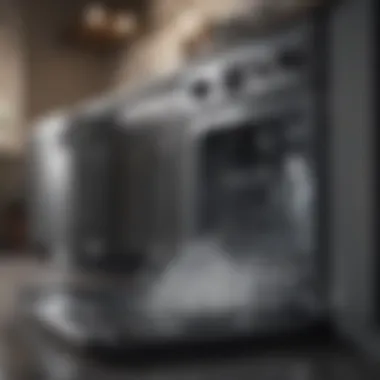DIY Guide: How to Fix Your Dishwasher Issues Independently


Interior Design Tips
When it comes to fixing your dishwasher yourself, it is essential to understand the intricate details of the machine's interior components. By exploring the inner workings of your dishwasher, homeowners can gain a deeper insight into potential issues that may arise. From assessing the cleanliness of the filter to examining the spray arm for blockages, a thorough inspection of the interior can reveal common problems that impact performance.
Entertaining Essentials
Understanding Dishwasher Mechanics
Understanding the mechanics of a dishwasher is essential for anyone looking to undertake DIY repairs without professional help. By comprehending how each component functions and interacts within the appliance, homeowners can troubleshoot issues effectively and make informed decisions when repairing their dishwasher. This section delves into the intricate inner workings of dishwashers, shedding light on the roles of different parts and highlighting the significance of grasping these mechanics for successful repairs.
Introduction to Dishwasher Components
Basic Parts Overview
When it comes to the basic parts of a dishwasher, one cannot overlook the significance of components like the pump, motor, heating element, and spray arm. Each plays a vital role in the operation of the dishwasher. The pump ensures proper water circulation, the motor drives the various functions of the appliance, the heating element aids in drying dishes efficiently, and the spray arm distributes water evenly for thorough cleaning. Understanding these basic parts is crucial for diagnosing and addressing common issues that may arise with your dishwasher.
Functions of Each Component
Exploring the functions of each dishwasher component offers invaluable insights into how this complex appliance operates seamlessly. For instance, the pump's function is to push water through the spray arms during the wash cycle, while the motor controls the pump and other moving parts. The heating element, on the other hand, heats the water for optimal cleaning and aids in drying dishes effectively. Understanding these functions empowers homeowners to troubleshoot malfunctions and ensure their dishwasher functions optimally.
Common Dishwasher Problems


No Water Entering
One prevalent issue homeowners may encounter is the dishwasher not filling with water. This problem can stem from a clogged water inlet valve, a faulty float switch, or a kinked water supply line. By understanding the causes behind this issue, individuals can take targeted steps to resolve it promptly and restore their dishwasher's functionality.
Not Draining Properly
A dishwasher failing to drain properly can lead to standing water in the appliance and unsanitary conditions. This problem often arises due to a clogged drain hose, a malfunctioning drain pump, or blockages in the filter. Identifying the root cause of poor drainage is crucial for maintaining the dishwasher's efficiency and preventing water damage in the kitchen.
Loud or Strange Sounds
Unusual noises emanating from a dishwasher can indicate underlying issues such as worn-out bearings, a damaged wash arm bearing ring, or debris trapped in the pump. Recognizing the source of these sounds is imperative in preventing further damage to the appliance and ensuring smooth operation during each wash cycle.
Troubleshooting Techniques
When delving into the realm of DIY dishwasher repair, mastering troubleshooting techniques becomes paramount. This section serves as the cornerstone of the entire article, imparting invaluable knowledge on identifying and addressing common dishwasher issues independently. By comprehensively explaining the diagnostic process and the tools required, this guide empowers homeowners to take charge of their appliance maintenance.
Diagnostic Process
At the core of troubleshooting lies the diagnostic process, a systematic approach to pinpointing malfunctions within the dishwasher. By meticulously assessing key components like the power supply and water inlet valve, individuals gain insights into the root cause of operational failures. This methodical examination not only streamlines repair efforts but also prevents unnecessary guesswork and potential errors that could exacerbate the problem.
Checking Power Supply
Among the pivotal aspects of the diagnostic process is checking the power supply. This step involves verifying the electrical connection to the dishwasher to ensure consistent and adequate energy flow. By validating this fundamental element, homeowners can rule out electrical issues as the source of malfunction, narrowing down the scope of potential causes for a precise and effective repair strategy. The reliability and simplicity of this procedure make it an indispensable tool in troubleshooting dishwasher malfunctions.


Inspecting Water Inlet Valve
Another critical component in the diagnostic process is inspecting the water inlet valve. This step involves scrutinizing the valve for potential blockages or damage that may impede proper water flow into the appliance. By meticulously examining this vital part, individuals can identify and address issues related to water supply, paving the way for a steady and efficient dishwasher operation. The thoroughness and precision of this inspection make it an essential step in diagnosing and resolving common dishwasher malfunctions.
Tools Required for Troubleshooting
Equipped with the right tools is akin to having a trusted ally in the realm of DIY dishwasher repair. This section elucidates the significance of essential instruments such as the multimeter, screwdriver set, and adjustable wrench in facilitating effective troubleshooting. By expounding on the unique functionalities and advantages of each tool, homeowners are primed to navigate the repair process with confidence and precision.
Multimeter
The multimeter emerges as a versatile and indispensable tool in the troubleshooting toolkit. Its ability to measure conductivity, voltage, and resistance enables individuals to conduct comprehensive electrical assessments with accuracy and efficiency. By leveraging the multifaceted capabilities of the multimeter, homeowners can diagnose electrical faults and calibrate components with precision, laying a solid foundation for successful dishwasher repairs.
Screwdriver Set
A well-appointed screwdriver set stands as a steadfast companion in navigating the intricacies of dishwasher troubleshooting. With a diverse array of screwdriver heads, this tool facilitates the disassembly and reassembly of dishwasher components with ease and precision. Whether tightening loose screws or dismantling intricate parts, the screwdriver set's versatility and durability make it an indispensable asset in the repair process.
Adjustable Wrench
The adjustable wrench emerges as a reliable and adaptable instrument essential for handling various nuts, bolts, and fittings during dishwasher maintenance. Its adjustable jaw width enables individuals to tackle a myriad of fastening tasks with ease, ensuring a secure and snug fit for components. As a sturdy and versatile tool, the adjustable wrench streamlines the repair process by simplifying adjustments and facilitating smooth disassembly and reassembly of critical dishwasher parts.
Fixing Common Issues
Fixing Common Issues is a crucial part of this comprehensive DIY guide on fixing your dishwasher yourself. By addressing common problems that may arise with your dishwasher, you can avoid the need for professional help and save both time and money. The section on Fixing Common Issues provides practical solutions and step-by-step instructions on how to resolve issues such as a clogged filter, a faulty door seal, or a blocked drain hose. By mastering these repair techniques, homeowners can take control of maintaining their dishwasher's functionality and efficiency. Understanding the importance of Fixing Common Issues empowers individuals to handle repairs independently and prolong the lifespan of their dishwasher.


Step-by-Step Repair Guide
- Cleaning the Filter: Cleaning the filter is a fundamental aspect of dishwasher maintenance. The filter plays a vital role in trapping debris and preventing it from clogging the dishwasher's internal components. By regularly cleaning the filter, you can ensure proper water flow, improve cleaning performance, and prevent potential breakdowns. The cleaning process generally involves removing the filter, rinsing it thoroughly, and reinserting it into its place. This simple yet effective task can significantly enhance the dishwasher's overall efficiency and longevity. Mastering the art of cleaning the filter is a beneficial skill for any homeowner looking to maintain their dishwasher in top condition. - Replacing Door Seal: The door seal, also known as the gasket, is a crucial component that creates a watertight seal when the dishwasher is in use. Over time, the door seal may wear out, resulting in water leaks or inefficient cleaning cycles. Replacing the door seal involves identifying the correct replacement part, removing the old seal, and installing the new one following manufacturer instructions. A properly functioning door seal ensures that water remains contained within the dishwasher during operation, preventing leaks and water damage. Learning how to replace the door seal is a valuable skill that can prolong the life of your dishwasher and optimize its performance. - Unclogging Drain Hose: A clogged drain hose is a common issue that can impede the dishwasher's drainage system, leading to water pooling at the bottom of the appliance. Unclogging the drain hose requires identifying the blockage location, disconnecting the hose, and clearing the obstruction using appropriate tools. By remedying this issue promptly, homeowners can prevent water backup and maintain proper drainage efficiency. Understanding how to unclog the drain hose empowers individuals to address this common problem swiftly and keep their dishwasher functioning smoothly.
Safety Precautions
- Shutting Off Power: Before beginning any repair work on your dishwasher, it is essential to shut off the power supply to prevent the risk of electric shock. Ensuring that the dishwasher is completely powered down minimizes the danger of accidental injuries and electrical hazards. Taking this precaution shows a responsible approach to repair work and prioritizes personal safety. Remembering to shut off the power is a fundamental safety measure that should be followed rigorously. - Avoiding Sharp Edges: Dishwasher components and tools used for repairs may have sharp edges that can cause cuts or injuries if mishandled. By being mindful of sharp edges and handling equipment with care, you can avoid accidents and ensure a safe repairing environment. Wearing protective gloves when working around sharp edges adds an extra layer of safety and reduces the risk of harm. Prioritizing safety by avoiding sharp edges demonstrates a conscientious approach to DIY repair activities.
Additional Tips and Resources
Preventive Maintenance
Regular Cleaning
Regular cleaning is a fundamental aspect of maintaining a dishwasher's functionality and prolonging its lifespan. By regularly cleaning the interior components, such as the filter, spray arms, and door seal, homeowners can prevent the buildup of dirt, grease, and food particles that could potentially lead to clogs and inefficiencies. This preventive measure not only ensures optimal performance but also contributes to the appliance's longevity. The key characteristic of regular cleaning is its ability to prevent issues before they escalate, thereby saving homeowners time and money in the long run. Its simplicity and effectiveness make it a popular choice for individuals looking to avoid costly repairs and keep their dishwasher running smoothly.
Using Dishwasher-safe Detergent
Opting for dishwasher-safe detergent is another critical component of effective preventive maintenance. Choosing a detergent specifically formulated for dishwashers helps to safeguard the appliance against damage and ensures that dishes are cleaned thoroughly without leaving behind residue. The unique feature of dishwasher-safe detergent lies in its gentle yet powerful formula that is designed to tackle tough stains and grease while protecting the dishwasher's internal components. Its advantages include improved cleaning performance, reduced risk of buildup, and increased efficiency, making it a suitable choice for homeowners seeking optimal results from their dishwasher.
Online Forums and Communities
Seeking Advice and Support
Engaging with online forums and communities provides homeowners with a valuable platform to seek advice and support from experienced individuals in the field of dishwasher repair. The key characteristic of seeking advice and support online is the direct access to a diverse range of perspectives and solutions that can help address specific issues or concerns. By leveraging the collective knowledge and experience of community members, homeowners can troubleshoot problems effectively and gain valuable insights into best practices for maintenance and repair. While the advantages of seeking advice online include convenience and quick responses, potential disadvantages may include varying quality of information and the need to validate recommendations before implementation.
Sharing Experiences
Sharing experiences within online forums and communities offers homeowners an opportunity to contribute to the collective knowledge base while benefiting from the practical insights of others. The key characteristic of sharing experiences is the exchange of firsthand accounts, tips, and strategies that have proven successful in resolving dishwasher-related issues. By sharing their own experiences, individuals can not only help others facing similar challenges but also receive feedback and suggestions for improvement. The unique feature of sharing experiences lies in its collaborative nature, fostering a sense of community and camaraderie among individuals with a common interest. While the advantages of sharing experiences include learning from real-world scenarios and building relationships within the community, potential disadvantages may include conflicting advice and varying levels of expertise.







